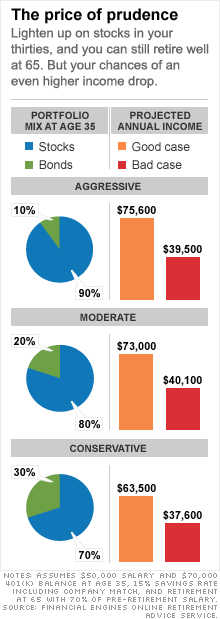Search News
(MONEY Magazine) -- I am 35 and consider myself an aggressive investor. I have at least 90% of my money in stock mutual funds. Am I being reckless by not putting more in bonds and cash? I've heard that a good rule of thumb is to limit your stock percentage to 110 less your age. But I feel like I will be giving up so much in potential gains. -- Chris Nowicki, Flat Rock, Mich.
I don't think you're reckless for having 90% of your long-term investments in stocks, as long as you're aware of (and truly comfortable with) the often bumpy ride equities provide.

But I do give a thumbs-down to relying on a rule of thumb. For years, the accepted wisdom was to subtract your age from 100 to get the percentage of assets that should go into equities. In the '80s bull market, 100 morphed to 110. When the stock feeding frenzy of the '90s dotcom boom took hold, 120 became the standard. You have to question a benchmark that changes with shifting investor sentiment.
Still, this rule is a useful framework for how you should think about stocks' superior return potential. No matter the number, the point holds that you should emphasize stocks when you have plenty of time to recover from setbacks, and dial back as you age and preserving capital becomes a higher priority.
To come up with an ideal stock target, however, most advisers look not just at your age but also how much you can save and how you react when the market tanks.
Another factor is your earnings potential. If you work in an industry where layoffs are common or pay can fluctuate dramatically (think financial services or real estate), you might want to offset that risk by owning more bonds. With a more predictable income, you can tilt a bit more toward stocks.
Taking all those factors into account, a typical recommendation for a person your age is to keep anywhere from 70% to 90% of your long-term investments in stocks. So you're on the high end.
With any of those stock allocations -- along with good savings habits throughout your career -- you should be able to retire comfortably, according to the advice firm Financial Engines.
Your fear that you'll give up potential returns if you dial back your stock stake, though, isn't unfounded. As the graphic in the left column shows, the more you put in stocks, the more income you're likely to have in retirement.
We're talking potential, though, not a guarantee. Because of their higher volatility, stocks have a greater downside risk. And you have to live with the day-to-day gyrations and ever-present possibility of a serious setback.
You don't seem bothered by the threat of a downturn, yet I find that feelings about risk tolerance change when a market collapse wipes out a big portion of the money you've saved. That's good reason to be less gung-ho. ![]()

Carlos Rodriguez is trying to rid himself of $15,000 in credit card debt, while paying his mortgage and saving for his son's college education.
| Overnight Avg Rate | Latest | Change | Last Week |
|---|---|---|---|
| 30 yr fixed | 3.80% | 3.88% | |
| 15 yr fixed | 3.20% | 3.23% | |
| 5/1 ARM | 3.84% | 3.88% | |
| 30 yr refi | 3.82% | 3.93% | |
| 15 yr refi | 3.20% | 3.23% |
Today's featured rates: